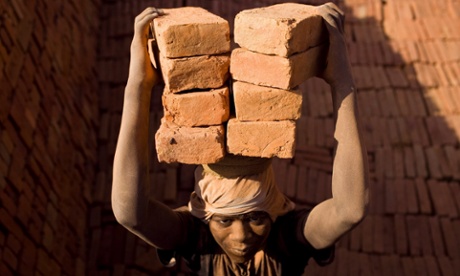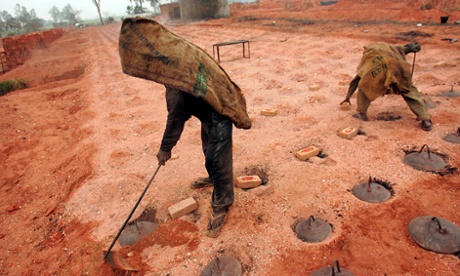After
children as young as four found working in squalid conditions, NGO
launches 'blood bricks' campaign to raise awareness of human rights
abuses in India's brick kilns

Across India, once small trading towns are transforming into bustling centres, as global companies flood in to set up call centres, factories and software development branches, eager to capitalise on high skill-sets at low labour prices. India's cities are expanding ever outwards to accommodate an expected 600 million people by 2030, when over 40% of the country's population will live in urban areas – compared to just 10% a century ago. But this miraculous metropolitan boom comes at a price.
On the outskirts of Hyderabad, the sprawling capital of the southern Indian state of Andhra Pradesh, thick clouds of smoke hang above a primal scene of bare-footed workers clambering atop kilns, hacking at mounds of clay and hauling heavy loads. This is just one of over 150,000 brick production units in the country, which together employ an estimated 10 million workers, churning out the building blocks of the new offices and apartments, factories and shopping malls. All told, India's brick industry – the second largest in the world after China – contributes around £3bn to the country's economy every year. Not that the workers see much of that.
“It's modern-day slavery,” says Andrew Brady, of Union Solidarity International (USI), a UK-based NGO that has been campaigning to improve the brick labourers' conditions over the last two years. “Entire families of men, women and children are working for a pittance, up to 16 hours a day, in terrible conditions. There are horrific abuses of minimum wage rates and health and safety regulations, and it's often bonded labour, so they can't escape.”

The six-month production season is now beginning, when tens of thousands of families flock to work in the brick kilns of Andhra Pradesh, mostly travelling from the state of Orissa. A report by the BBC this week discovered children as young as four smashing coal to fuel the kilns, and stories of labourers having their hands cut off when they tried to leave their jobs. The report found workers forced to produce over 1,500 bricks every day, paid in advance and only able to leave after six months, along with children suffering from severe respiratory problems.
Read More Here




No comments:
Post a Comment
Hello and thank you for visiting my blog. Please share your thoughts and leave a comment :)